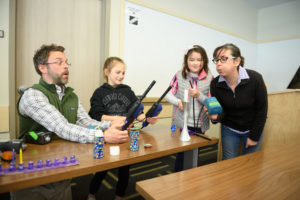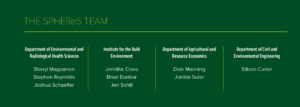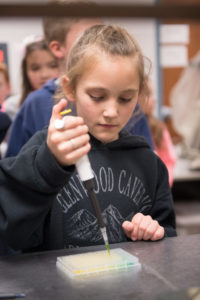On a sunny winter morning, 52 fourth-graders pour noisily into a classroom at Colorado State University. They have spent nearly two hours on a bus to travel from STEM Lab, an elementary school in Northglenn, Colo., to the Fort Collins campus, and they are buzzing with pent-up energy. For most of them, this is their first time in a college classroom. If the day goes as planned, they will leave inspired to attend college and study science.

So, how do you get 9-year-olds excited about science?
“We’re going to light things on fire!” says Sheryl Magzamen, associate professor of epidemiology in the College of Veterinary Medicine and Biomedical Sciences.
The students cheer. It’s a good start to a busy morning. In hands-on labs, the students will learn how to calibrate instruments, how to measure indoor air quality, how to take accurate notes, and how to dilute a sample for a bacterial assay.
Not only are they learning how to act like scientists, they are also learning how to think like scientists – like epidemiologists. Magzamen leads the students through a brainstorm about everything in the environment that might impact their health, from cars, roads, and air pollution, to rivers, trees, and sunlight. These fourth-graders are learning to think about relationships, to move from the concrete to the abstract, to connect inputs to outcomes, and to make inferences, all so they can help Magzamen and her colleagues answer a very big question:
Does your school help you learn? Or does it make you sick?
A national crisis
Public schools in the United States face an infrastructure crisis that affects the health and performance of 50 million children and more than 3 million teachers. The average student spends 1,000 hours a year in a classroom, and the average public school building is more than 50 years old. In 2013, public schools needed an estimated $197 billion for repairs and renovations. For decades to come, municipalities and taxpayers will face difficult choices as they invest in aging buildings and build new schools.
“We can make sure that kids and teachers have healthy learning and work environments. If kids get sick at school, if they’re tired, if they can’t concentrate because of light or noise, then they’re just not going to be good learners.”
SHERYL MAGZAMEN
At Colorado State University, a multidisciplinary research team called Sustainable Places, Health and Educational Research in Schools aims to help schools and their stakeholders make the best possible choices for generations of students and teachers. The SPHEReS team consists of researchers from four disciplines, including Magzamen.

“We know this school ecosystem is super complex and we are not going to be able to tackle every issue, but one of the awesome things about schools is that these are collective community investments,” Magzamen says. “No one is going to argue we should have bad schools. It’s something we can all agree is important. And that makes it a good place to do research.”
SPHEReS has partnered with Adams 12 Schools north of Denver to examine the impact of school environment on occupant health and performance. Funded by the Environmental Protection Agency, the Healthy Schools project is truly innovative: it’s the first time that epidemiologists, sociologists, economists, and sustainability experts have collaborated at this scale to address this question.
 Adams 12 is an excellent partner for the Healthy Schools project. The school district reflects the nation’s challenges: it’s urban, it’s growing rapidly, it’s economically and ethnically diverse, its core building stock is nearing the end of its functional lifespan, and, in 2016, voters passed a bond to fund $350 million for school infrastructure.
Adams 12 is an excellent partner for the Healthy Schools project. The school district reflects the nation’s challenges: it’s urban, it’s growing rapidly, it’s economically and ethnically diverse, its core building stock is nearing the end of its functional lifespan, and, in 2016, voters passed a bond to fund $350 million for school infrastructure.
Where problems meet solutions
At three schools – STEM Lab, STEM Launch, and Northglenn High School – teachers have embraced the Healthy Schools project by embedding it in Problem-Based Learning, a teaching method that empowers students to solve real-world problems.
“Our students wrestle with complex problems and come up with their own solutions. The fact that their work is really science hooks them,” says Mathis Santella, a fourth-grade teacher at STEM Lab. “They are naturally curious and we leverage that curiosity. During problem-based learning, the kids will go and change what’s happening in their family and will come back and make connections. They think they are capable of making change in the world around them. There’s a problem? Go and find a solution.”

STEM Lab is the ideal setting for the Healthy Schools project. The students and teachers were already familiar with community-based research, and the facilities were representative of the national school infrastructure problem. The original 1968 building needed extensive renovations, including a new roof, water main, and HVAC system, plus they needed more room to accommodate the growing magnet school. The district added a new wing in 2018 and then renovated the 1968 structure. The fourth-graders looked at the school’s indoor air quality and carbon footprint, as well as the affective impact of their learning environment.
“We have data collected by the CSU team before and after construction, and we’re collecting our own data. We don’t know yet what the students are producing in this unit. Usually, they figure it out,” Santella explains. “The teachers are not the owners of the knowledge. We’re more like the bumpers in a bowling lane.”
From failure to justice
Science can be a messy process – for students and adults. The CSU team has run into countless obstacles, like building closures and malfunctioning equipment. Their fourth-grade counterparts are also learning how to adapt to challenges.
But Tracey Wise-Calderon, the STEM Coordinator at STEM Lab, believes failure is essential to the learning process: “We build in opportunities to completely fail. The kids might come up with a solution and take it to an expert and that person will challenge their idea. They become better critical thinkers and questioners through this process. They want to hurry up and fail so they know what to fix.”
The fourth-graders will wrap up their project this spring, but the SPHEReS team has a long road ahead of them. They will collect and analyze two more years of data, and they anticipate publishing at least a dozen scientific articles. Their research will help schools and municipalities make smart decisions about healthy learning environments for decades to come. Ultimately, it could be a significant chapter in the story of environmental justice.
“I like being in the community. It’s the mission of CSU. We want to take our campus knowledge and translate it for the beneft of the state’s citizens.”
SHERYL MAGZAMEN
Magzamen is pragmatically hopeful about the impact of the Healthy Schools project: “We know from research that so much of school achievement is tied to parent class and education. We don’t have a great chance of fixing that, but we can make sure that kids and teachers have healthy learning and work environments. If kids get sick at school, if they’re tired, if they can’t concentrate because of light or noise, then they’re just not going to be good learners.”